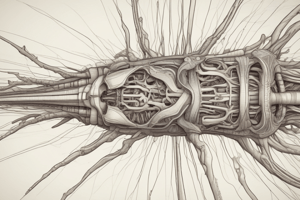Podcast
Questions and Answers
¿Cuál es la función principal del madde blanco en la médula espinal?
¿Cuál es la función principal del madde blanco en la médula espinal?
- Procesar y transmitir información
- Protegida la médula espinal de lesiones
- Contener cuerpos celulares de neuronas
- Transmitir señales eléctricas entre el cerebro y el cuerpo (correct)
¿Cuántos segmentos se dividen la médula espinal?
¿Cuántos segmentos se dividen la médula espinal?
- 31 (correct)
- 20
- 25
- 35
¿Qué tipo de información transmiten las raíces dorsales?
¿Qué tipo de información transmiten las raíces dorsales?
- Información sensorial del cuerpo al cerebro (correct)
- Señales auditivas del oído al cerebro
- Señales motoras del cerebro a los músculos
- Información visual del ojo al cerebro
¿Cuál es el tracto descendente que se origina en la corteza cerebral y es responsable del control motor?
¿Cuál es el tracto descendente que se origina en la corteza cerebral y es responsable del control motor?
¿Cuál es la función principal del madde gris en la médula espinal?
¿Cuál es la función principal del madde gris en la médula espinal?
¿Cuál es la función de los neuronas motoras en la cuerna anterior o ventral?
¿Cuál es la función de los neuronas motoras en la cuerna anterior o ventral?
¿Cuál es la función principal de la sustancia blanca?
¿Cuál es la función principal de la sustancia blanca?
¿Cuál es la capa más interna de las meninges?
¿Cuál es la capa más interna de las meninges?
¿Cuál es la función de los nervios raquídeos?
¿Cuál es la función de los nervios raquídeos?
¿Cuántas pares de nervios raquídeos hay en la médula espinal?
¿Cuántas pares de nervios raquídeos hay en la médula espinal?
Flashcards are hidden until you start studying
Study Notes
Spinal Cord Anatomy: An In-Depth Look
Spinal Cord Layers
The spinal cord is a long, cylindrical structure that extends from the foramen magnum at the base of the skull to the level of the first or second lumbar vertebrae. It is composed of two main components: white matter and gray matter. The white matter is located on the outermost surface and is responsible for transmitting electrical signals via axons between the brain and various parts of the body. The gray matter, on the other hand, is located in the core of the spinal cord and contains cell bodies of neurons that process and transmit information.
Nerve Roots
The spinal cord is divided into 31 segments, each with its own pair of nerve roots. These roots exit the spinal cord through the intervertebral foramina, which are located between the vertebrae. The dorsal and ventral roots of the spinal cord enter and leave the vertebral column, respectively. The dorsal roots are sensory, carrying information from the body to the brain, while the ventral roots are motor, transmitting signals from the brain to the muscles and organs.
White Matter
The white matter of the spinal cord consists of three funiculi: posterior, lateral, and anterior. Each funiculus contains both ascending and descending tracts, which enable communication between the brain and the body. The corticospinal tract, a major descending tract, originates in the cerebral cortex and is responsible for motor control.
Gray Matter
The gray matter of the spinal cord can be divided into 10 laminae or layers. The anterior or ventral horn contains motor neurons that innervate skeletal and smooth muscles. The posterior or dorsal horn contains sensory neurons that process sensory information. The intermediate zones contain associate neurons, and the lateral horns house sympathetic neurons in the thoracic and lumbar segments.
Meninges
The spinal cord is encased in three layers of meninges: the dura mater, arachnoid, and pia mater. The dura mater is the toughest and outermost layer, followed by the arachnoid, and the pia mater is the innermost layer that directly adheres to the surface of the spinal cord. The spinal cord is attached to the dura by a series of lateral denticulate ligaments.
In summary, the spinal cord is a complex structure that plays a crucial role in the communication between the brain and the body. Its anatomy is segmentally organized, with 31 pairs of spinal nerves that exit the cord at specific levels along the vertebral column. The spinal cord is composed of white and gray matter, with the white matter responsible for transmitting electrical signals and the gray matter containing the cell bodies of neurons that process and transmit information. The spinal cord is protected by the meninges, and its nerve roots are responsible for sensory and motor functions.
Studying That Suits You
Use AI to generate personalized quizzes and flashcards to suit your learning preferences.




